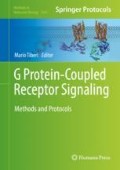Abstract
Fluorescence techniques represent a powerful tool to investigate dynamic and functional architecture of GPCRs. Thus, fluorescent GPCR ligands have found various applications in cellular imaging, in the development of binding assays as replacements for radioligands in the study of ligand–receptor but also in receptor–receptor interactions at the cell surface or in native tissues. To extend the applicability of these techniques, the design and the synthesis of fluorescent probes are critical steps. As there are numerous peptide receptors in the GPCR family, fluorescent peptide-based probes are of importance. Herein, we present a convenient method to facilitate the solution-phase fluorescent labeling of peptides which is based on the chemoselective acylation of α-hydrazinopeptides. This approach combines the advantages to use commercially available amine-reactive dyes and very mild conditions that are fully compatible with the chemical sensitivity of the dyes. It gives a rapid access to fluorescent peptidic probes compatible with the time-resolved fluorescence resonance energy transfer (TR-FRET) techniques.
Access this chapter
Tax calculation will be finalised at checkout
Purchases are for personal use only
References
Ma Z, Du LP, Li MY (2014) Toward fluorescent probes for G-Protein-Coupled Receptors (GPCRs). J Med Chem 57(20):8187–8203. https://doi.org/10.1021/jm401823z
Congreve M, Langmead CJ, Mason JS, Marshall FH (2011) Progress in structure based drug design for G protein-coupled receptors. J Med Chem 54(13):4283–4311. https://doi.org/10.1021/jm200371q
Sridharan R, Zuber J, Connelly SM, Mathew E, Dumont ME (2014) Fluorescent approaches for understanding interactions of ligands with G protein coupled receptors. Biochim Biophys Acta 1838(1):15–33. https://doi.org/10.1016/j.bbamern.2013.09.005
Karpenko IA, Klymchenko AS, Gioria S, Kreder R, Shulov I, Villa P, Mely Y, Hibert M, Bonnet D (2015) Squaraine as a bright, stable and environment-sensitive far-red label for receptor-specific cellular imaging. Chem Commun 51(14):2960–2963. https://doi.org/10.1039/c4cc09113b
Karpenko IA, Margathe JF, Rodriguez T, Pflimlin E, Dupuis E, Hibert M, Durroux T, Bonnet D (2015) Selective nonpeptidic fluorescent ligands for oxytocin receptor: design, synthesis, and application to time-resolved FRET binding assay. J Med Chem 58(5):2547–2552. https://doi.org/10.1021/jm501395b
Zwier JM, Roux T, Cottet M, Durroux T, Douzon S, Bdioui S, Gregor N, Bourrier E, Oueslati N, Nicolas L, Tinel N, Boisseau C, Yverneau P, Charrier-Savournin F, Fink M, Trinquet E (2010) A fluorescent ligand-binding alternative using Tag-lite (R) technology. J Biomol Screen 15(10):1248–1259. https://doi.org/10.1177/1087057110384611
Loison S, Cottet M, Orcel H, Adihou H, Rahmeh R, Lamarque L, Trinquet E, Kellenberger E, Hibert M, Durroux T, Mouillac B, Bonnet D (2012) Selective fluorescent nonpeptidic antagonists for vasopressin V-2 GPCR: application to ligand screening and oligomerization assays. J Med Chem 55(20):8588–8602. https://doi.org/10.1021/jm30061461
Albizu L, Cottet M, Kralikova M, Stoev S, Seyer R, Brabet I, Roux T, Bazin H, Bourrier E, Lamarque L, Breton C, Rives ML, Newman A, Javitch J, Trinquet E, Manning M, Pin JP, Mouillac B, Durroux T (2010) Time-resolved FRET between GPCR ligands reveals oligomers in native tissues. Nat Chem Biol 6(8):587–594. https://doi.org/10.1038/Nchembio.396
Tornoe CW, Christensen C, Meldal M (2002) Peptidotriazoles on solid phase: [1,2,3]-triazoles by regiospecific copper(I)-catalyzed 1,3-dipolar cycloadditions of terminal alkynes to azides. J Org Chem 67(9):3057–3064. https://doi.org/10.1021/jo011148j
Bonnet D, Riche S, Loison S, Dagher R, Frantz MC, Boudier L, Rahmeh R, Mouillac B, Haiech J, Hibert M (2008) Solid-phase organic tagging resins for labeling biomolecules by 1,3-dipolar cycloaddition: application to the synthesis of a fluorescent non-peptidic vasopressin receptor ligand. Chem Eur J 14(20):6247–6254. https://doi.org/10.1002/chem.200800273
Terrillon S, Cheng LL, Stoev S, Mouillac B, Barberis C, Manning M, Durroux T (2002) Synthesis and characterization of fluorescent antagonists and agonists for human oxytocin and vasopressin V-1a receptors. J Med Chem 45(12):2579–2588. https://doi.org/10.1021/jm010526+
King M, Wagner A (2014) Developments in the field of bioorthogonal bond forming reactions—past and present trends. Bioconjug Chem 25(5):825–839. https://doi.org/10.1021/bc500028d
Kolb HC, Finn MG, Sharpless KB (2001) Click chemistry: diverse chemical function from a few good reactions. Angew Chem Int Ed Engl 11:2056–2075. https://doi.org/10.1002/1521-3773(20010601)40:11<2004::Aid-Anie2004>3.0.Co;2-5
Bonnet D, Ilien B, Galzi JL, Riche S, Antheaune C, Hibert M (2006) A rapid and versatile method to label receptor ligands using “click” chemistry: validation with the muscarinic M1 antagonist pirenzepine. Bioconjug Chem 17(6):1618–1623. https://doi.org/10.1021/bc060140j
Margathe JF, Iturrioz X, Regenass P, Karpenko IA, Humbert N, de Rocquigny H, Hibert M, Llorens-Cortes C, Bonnet D (2016) Convenient access to fluorescent probes by chemoselective acylation of hydrazinopeptides: application to the synthesis of the first far-red ligand for apelin receptor imaging. Chem Eur J 22(4):1399–1405. https://doi.org/10.1002/chem.201503630
Bonnet D, Ollivier N, Gras-Masse H, Melnyk O (2001) Chemoselective acylation of fully deprotected hydrazino acetyl peptides. Application to the synthesis of lipopeptides. J Org Chem 66(2):443–449. https://doi.org/10.1021/Jo0010577
Chan W, White P (2000) Fmoc solid phase peptide synthesis. A practical approach. Oxford University Press, Oxford
Montalbetti CAGN, Falque V (2005) Amide bond formation and peptide coupling. Tetrahedron 61(46):10827–10852. https://doi.org/10.1016/j.tet.2005.08.031
Bonnet D, Grandjean C, Rousselot-Pailley P, Joly P, Bourel-Bonnet L, Santraine V, Gras-Masse H, Melnyk O (2003) Solid-phase functionalization of peptides by an alpha-hydrazinoacetyl group. J Org Chem 68(18):7033–7040. https://doi.org/10.1021/jo0343432
Acknowledgements
The development of the method was supported by the Fonds Unique Interministériel (Cell2lead program n° F1005035J/ATFUAA00LB/AAP9), the Centre National de la Recherche Scientifique and the Université de Strasbourg. Sridévi M. Ramanoudjame and Lucie Esteoulle contributed equally to this work.
Author information
Authors and Affiliations
Corresponding author
Editor information
Editors and Affiliations
Rights and permissions
Copyright information
© 2019 Springer Science+Business Media, LLC, part of Springer Nature
About this protocol
Cite this protocol
Ramanoudjame, S.M. et al. (2019). Chemoselective Acylation of Hydrazinopeptides to Access Fluorescent Probes for Time-Resolved FRET Assays on GPCRs. In: Tiberi, M. (eds) G Protein-Coupled Receptor Signaling. Methods in Molecular Biology, vol 1947. Humana Press, New York, NY. https://doi.org/10.1007/978-1-4939-9121-1_7
Download citation
DOI: https://doi.org/10.1007/978-1-4939-9121-1_7
Published:
Publisher Name: Humana Press, New York, NY
Print ISBN: 978-1-4939-9120-4
Online ISBN: 978-1-4939-9121-1
eBook Packages: Springer Protocols

